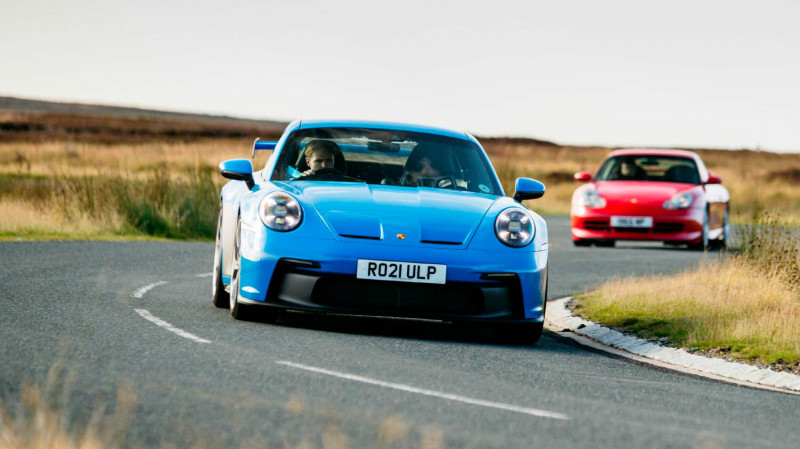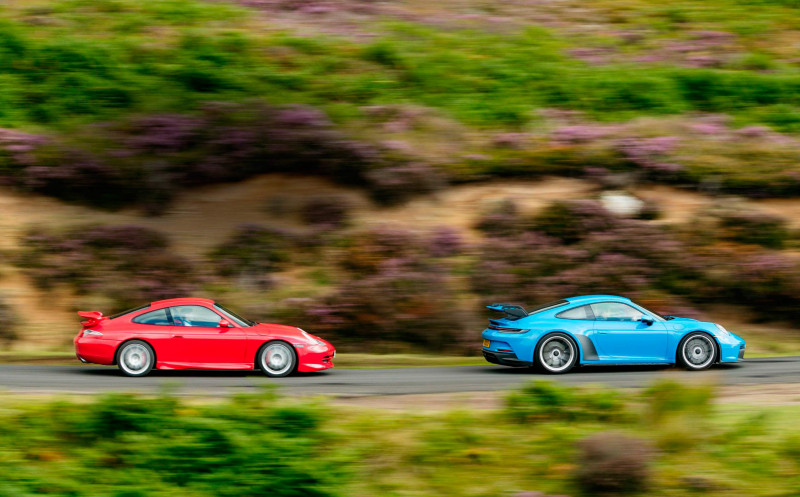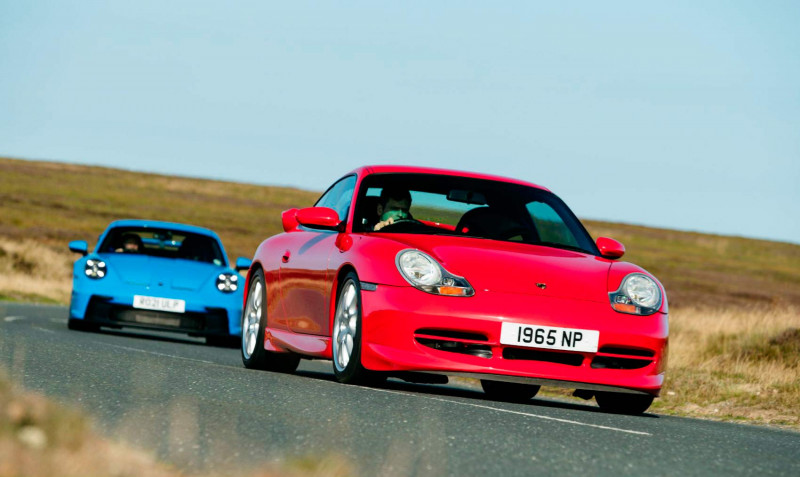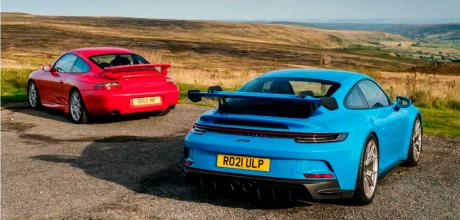2021 Porsche 911 GT3 992 vs 1999 911 GT3 996.1
Total 911 explores Porsche’s GT3 bloodline with a fast road drive of the first and latest homologation specials.Written by Lee Sibley. Photography by Ali Cusick Legacy.
Legacy of GT3
Lee Sibley examines nearly 25 years of GT3 development with a back-to-back test of the first and latest examples
It’s easy to forget just how much change has taken place at Porsche in the last quarter of a century. In that time, the 911 lineup has flourished both in the number of different models available as well as numbers produced – comfortably more 911s have been made in the last 25 years than the 33 beforehand.

Porsche also diversified its products by introducing the Cayman, Cayenne, Panamera, Boxster and Macan, as well as the Carrera GT and 918 supercars; then it opened eight new experience centres worldwide, a new factory at Leipzig (with a micro factory currently being assembled in Malaysia); got taken over by VW; and started making electric cars, beginning with the Taycan. Pretty much the only constant has been the location of Porsche’s HQ at Zuffenhausen, where the 911 continues to be built, albeit alongside said Taycan.
Even at Zuffenhausen though, a new era was being ushered in precisely 25 years ago: its 911 was completely redesigned from the ground up for the first time since the model’s inception in 1963. A new car, the Boxster, would be built alongside it, sharing a variation of the same engine – an engine that would be cooled by water rather than air. Today, these facts are immaterial to the enthusiast. A quarter of a century ago, the move was seismic.

Two short years later, the company was also saying hello to a new age for its Motorsport cars with the fabled Carrera RS expunged in favour of a model sporting just two letters and a number: GT3. In the first instance, Porsche’s new car from Weissach would homologate the 996 to go racing, in the best traditions of a Porsche sports car. But it would do much more than that: the first ‘hot’ 996 would start a deep love affair between devout driving enthusiasts and pretty much anything to roll out of what is now known as the ‘GT Department’. Nearly 25 years and the production of 20,000 models over seven generations later (not including RS), the ‘GT3’ appellation might well be the most evocative in the Porsche lexicon.
The latest and greatest of those is of course the 992 GT3. We have previously tested it on its customary proving ground, the race track. But the magic of the GT3 as a homologation special is that while its skills are honed for the circuit, it’s also applicable to street driving.
Around town, there’s no question it’s an easier proposition than the 991.2 it replaced: the clutch and shifter are much lighter and easier to engage – even from cold – and mechanical chatter from the clutch release bearing is less perceptible in the cabin, which also filters out a degree of rolling tyre noise too. It’s not as agricultural in urban areas as the 991.2, which makes daily driving a semi-realistic proposition, though a stiff ride should still deter all but the most committed of enthusiasts.

That’s not to say the GT3 experience has been diluted in the latest offering. Even at low speeds, its front axle feels sharper, and whereas in the 991 you had to be hitting the upper echelons of its maximum 9,000rpm for the motor to really sing, here the flat six symphony begins in earnest from as little as 5k. Clearly, the bandwidth of the GT3’s performance has been increased, but great roads are where it pleases most, which is why we find ourselves in the middle of nowhere on the North York Moors, with an old friend in tow. A fun, smooth(ish) network of roads running mostly in parallel over these picturesque moors, they are simply a paradise for those who love driving – and my current predicament is equally as heavenly.
The view ahead consists of a winding road twisting excitedly over quiet moorland; the view behind is dominated by the swan neck uprights of the 992’s wing but behind that, a flash of red reveals Neil Plumpton’s 996.1 GT3. Separated by 22 years, these two homologation specials neatly bookend Porsche’s GT3 story – and as we’ve just discovered, much has changed at the company in the interim. So is it reflected in the cars that share a name?
Our drive of the new Touring in issue 208 revealed the 992 GT3’s front axle to be a quantum leap over the 991, so quick and sharp is the car at its nose. However, there are differences – albeit subtle – between the Touring and this track-oriented, winged equivalent. Its ride is slightly stiffer, for one, and the steering wheel is noticeably busier over bumpy blacktop too, requiring something of a wrestle to keep the car from tramlining all over the road’s divots. Another big difference to that drive in the Touring concerns the GT3’s transmission. Our Touring on test was PDK, whereas this winged GT3 has Porsche’s six-speed Motorsport gearbox – and what a revelation it is. Sporting the lightest pedal of any Porsche GT car I’ve driven, the shifter too is fairly weightless (but not superfluously so), offering a short, precise throw.

It’s simply a joy to use and is the best ally yet to the brilliant 510hp, 4.0-litre flat six stuffed out back. My only gripe is pedal positioning. It’s less than ideal in the 992, the accelerator’s organ pedal placed too far over and with too much of an offset to the brake pedal to facilitate seamless heel and toe. There is a cheat though, as selecting Sport mode sees the car automatically rev match to keep the GT3 smooth between downshifts, while on the way back up, the GT3 reveals another neat feature of its arsenal: flat shifting. In the 992 there’s no need to lift off the throttle when changing up a gear, thereby reducing the amount of time the 911’s rear wheels are starved of power. Instead, with my right foot planted to the floor, a kick at the clutch with my left foot and a swift slide of the shifter sees the GT3 accept a deft gear change in rapid time. That, and the fact it can tap into an additional 100Nm of torque, means the thunderous 992 can muster a sizeable margin of space to its distant forebear in a straight line, though in corners the latest GT3 has the ability to dust off the 996 completely.
The 992’s mechanical grip is simply astonishing. Unrivalled among other road-based 911s, the sheer speed I’m able to carry through bends is frankly ludicrous, and yet the GT3 never feels like it’s even remotely beginning to tickle the limits of adhesion. No matter how hard I push, or how bumpy the road becomes, this GT3 refuses to break contact with the floor, which is evidently a key factor behind its ability to cover ground so quickly and with such assurance.
After an hour or so of playing cat and mouse across the moors, we pull over for a debrief, and Neil – a serial owner of more than 30 Porsche in the last 16 years – is equally stunned by the 992’s grip. “That thing’s mad,” he says, pointing at the Shark blue car. “There were a couple of times you went into a corner with such speed, I thought surely you’d be in trouble, but it just gripped and gripped. I can’t believe it.” It’s an an apt appraisal indicative of the 992 GT3’s sizeable capabilities, rather than those of the wally in charge of steering it.
Before Neil and I swap cars, we take in their profiles on the hillside. Even when merely parked next to one another, it’s hard to believe these two 911s share much more in common than the model denomination stamped to their backsides. The sculpted 996 is small and dainty compared to the jagged 992 with its more aggressive styling. Aesthetically, the 996 is only a minor rework over its Carrera sibling: still narrow-bodied and with exhausts remaining faithful to the 911’s rear corners, there are none of the extra vents that would appear ahead of the bonnet and on the rear PU from the 997 onwards either. Even the bi-planed ‘taco’ wing sitting atop the decklid feels reassuringly minuscule compared to the 992’s swan-necked approach to aerodynamics.
The 996 does sit 30mm lower than its C2 sister though, plus there’s a raft of changes you don’t immediately see like adjustable dampers, stiffer springs, bigger brakes, plus a 993 GT2-spec gearbox and dry-sumped ‘Mezger’ flat six in the back.
Stepping into the 996, it really does hit home just how much the GT3 has evolved in the years under Mr Preuninger’s tutelage. This first GT3 may have heralded the modern era of Porsche GT car, but to experience it really is like going back in time. The simplicity of its cabin is indicative of the 996’s general approach to fast motoring: there’s no Sport button, let alone a Mode wheel as part of any Sport Chrono Package. As for the Sport setting of Porsche Stability Management, with its greater slip angle? The only tools for mitigating traction here are your feet and hands.
I’m sat far higher up in the 996 too (though the Clubsport leather buckets offer an excellent hold), the steering wheel placement feels awkward, the only adjustment being a forwards/backwards movement, and the manual shifter feels like it’s placed somewhere down near my knees. It shows Porsche really has honed the driver’s seating position to perfection in the years since.

We venture back out on the same roads we’ve just explored, where it takes just seconds for Porsche’s first GT3 to endear itself to me. Vision, first of all, is first class: I can see all the 996’s extremities from the driver’s seat, which makes placing this stunning, 35,000 mile example on the road a far easier task than in the bulky 992. Its pedals too are ideally placed and offer the perfect tools for quick heel and toe, even if the clutch has such weight to it that it feels akin to a gymnasium leg press.
The wheel is jostling about in the palms of my hands, and the chassis is already showing itself to be playful as we move through a succession of medium-speed bends. Building pace, the M96/79 boxer shows plenty of character and eagerness to rev to its 7,600rpm redline as I try and chase down the 992. Before long we reach a fast, darting S-bend, where earlier the 992’s lightning-quick directional changes and ability to maintain grip had left both Mr Plumpton and I dumbfounded.
Needless to say, the 996 will not carry anywhere near as much velocity into this first right-hander, and so while the 992 monsters on, I’m hitting the 996’s brakes to scrub speed for an acceptable corner entry. Turning in, it takes a while for the car’s nose to follow my inputs at the wheel by comparison to the razorsharp 992, but the process in this 996 is nevertheless beautiful: you feel so much more of everything, from rear to front load, to lateral weight transfer, to the (at times) teetering levels of grip being eked from those much skinnier Pirelli tyres.
The 996 darts right, I then lift slightly, push the wheel left and feed the throttle in, before accelerating hard out of the S-bend… wow! This GT3 feels alive in my grasp, and at considerably less speed than the 992 needs to muster to deliver the same feeling. The 996 just feels so playful: whereas in the 992 you never quite feel in sole charge of the car, the 996.1 lets you take it by the scruff of the neck, giving you complete autonomy to find yours or the car’s limit, whichever comes first. The experience rewards on a whole new level, and really highlights why many view this precomputer era as the high watermark of sports cars, if not in terms of their technical prowess but the sheer engagement they offer. So how to compare the first and latest Porsche GT3?
Really, there’s no comparison to be had between the 996.1 and 992. They hail from completely different eras, and it shows. There’s an innocence to the 996 in its approach to performance, yet the 992 is simply a technical masterpiece, the result of more than two decades of obsessive attention to every gram of weight, every drop of petrol, and every molecule of air that goes near it. The 992 GT3 is a race car with a sat nav, whereas the 996 is simply a classic sports car.
However, on a public road, the barometer of accomplishment is smiles, not sector times, which puts the 996 eye to eye with its distant, exuberant relative in the 992. On this metric alone, choosing a champion is difficult.
It’s hard to look past the sheer theatre of the 992, but as we get our final shot at sunset to wrap up an entertaining day on the moors, it doesn’t stop me from asking Neil if I can drive his 996 back to base for a late evening supper. There’s just something about its purity through simplicity that I’m drawn to, and I’m keen to savour it one last time.
And that’s how our day ends: two GT3s chasing down the very last remnants of sunlight en route back to civilisation, the 996 and I following the warm glow of the 992’s full-width rear light bar as it dances in the darkness across the deserted moorland roads. Where to from here? Only Mr Andreas Preuninger really knows for the short term, but one thing’s for certain: in another 22 years’ time, Porsche’s GT3 will be another very different beast indeed.
- Model Porsche 911 GT3 992
- Year 2020
- Engine
- Capacity 3,996cc
- Compression ratio 13.3:1
- Maximum power 510hp @ 8,400rpm
- Maximum torque 470Nm @ 6,100rpm
- Transmission Six-speed manual
- Suspension
- Front Independent; double wishbone with anti-roll bar; all chassis mounts ball joints; integrated helper spring; PASM
- Rear Independent; multi-link; antiroll bar; partial chassis bearings with ball joints; integrated helper spring; PASM
- Wheels & tyres
- Front 9.5x20-inch; 255/35/ZR20
- Rear 12x21-inch; 315/30/ZR21
- Dimensions
- Length 4,573mm
- Width 1,852mm
- Weight 1,418kg
- Performance
- 0-62mph 3.9 secs (manual)
- Top speed 199mph
BELOW Swan neck strut design is a first on a road 911 and generates 50% more downforce over 991.2 (combined with diffuser). BELOW Refined driver position contributes to a lower centre of gravity.

“On a public road, the barometer of accomplishment is smiles, not sector times, which puts the 996 eye to eye with its distant, exuberant relative in the 992”
- Model 996.1 GT3
- Year 1999
- Engine
- Capacity 3,600cc
- Compression ratio 11.7:1
- Maximum power 360hp @ 7,200rpm
- Maximum torque 370Nm @ 5,000rpm
- Transmission Six-speed manual
- Suspension
- Front Independent; MacPherson strut; anti-roll bar
- Rear Independent; multi-link; anti-roll bar
- Wheels & tyres
- Front 8x18-inch; 225/40/R18
- Rear 10x18-inch; 285/30/R18
- Dimensions
- Length 4,430mm
- Width 1,765mm
- Weight 1,350kg
- Performance
- 0-62mph 4.8 sec
- Top speed 188mph
ABOVE 996.1 GT3 actually weighed 30kg more than an equivalent C2, but boasted a dry-sumped ‘Mezger’ engine, uprated chassis and bigger brakes.
BELOW Angle of biplaned ‘taco’ wing could be manually adjusted.

ABOVE The 996 GT3’s cabin is indicative of a time when simplicity was king, with no buttons or toggles to activate driver modes or chassis aids.


